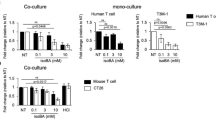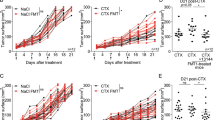Abstract
We have recently demonstrated that a treatment combining the cell differentiating agent sodium butyrate (NaBut) and interleukin-2 (IL2) resulted in a remission of established peritoneal colorectal carcinomatosis in rats. NaBut or IL2 treatment alone, never cured these tumour-bearing rats. In the present investigation, we report that NaBut-treatments induce apoptosis in the colonic cancer cells both in vitro and in vivo. We postulated that the significant therapeutic effect of NaBut/IL2 treatment can be mainly attributed to a NaBut-induced apoptosis of the tumoural cells increasing their immunogenicity. Indeed, treatment which combined apoptotic bodies (apobodies) as cell vaccine, plus IL2 immunotherapy significantly increased tumour remission and survival rate of the vaccinated rats, whereas IL2 treatment alone did not. We observed that the cured rats presented long-term protection against subsequent challenge with the parental tumour cells. This latter result suggests that these treatments generate an immune protection. This was confirmed by the presence, in the sera of the cured rats, of anti-tumoural antibodies directed against both the apobodies and the tumour cells, but not against normal colonocytes. In addition, we show that injections of apobodies before administration of the parental tumour cells results in a partial protection. We provide the first evidence that apobodies, derived from cancer cells after NaBut-treatment, induce a specific immune response against parental tumours cells. These data suggest that the distinctive immunologic properties of apobodies could provide a valuable tool in colorectal cancer immunotherapy.
Similar content being viewed by others
References
Stevenson FK. Update on tumor vaccines. Int J Clin Lab Res 1992; 22: 84–89.
Beatty JD. Immunotherapy of colorectal cancer. Cancer 1992; 70: 1425–1433.
Moertel CG. Accomplishments in surgical adjuvant therapy for large bowel cancer. Cancer 1992; 5(Suppl 70): 1364–1371.
Perrin P, Cassagnau E, Burg C, et al. An interleukine 2/sodium butyrate combination as immunotherapy for rat colon cancer peritoneal carcinomatosis. Gastroenterology 1994; 107: 1697–1708.
Patry Y, Douillard JY, Meflah K, LePendu J. Immunization against a rat colon carcinoma by sodium butyrate-treated cells but not Interleukin 2-secreting cells. Gastroenterology 1995; 109: 1555–1565.
Gamet L, Daviaud D, Denis-Pouxviel C, Remesy C, Murat JC. Effects of short-chain fatty acids on growth and differentiation of the human colon-cancer cell line HT29. Int J Cancer 1992; 52: 286–289.
Hague A, Elder DJE, Hicks DJ, Paraskeva C. Apoptosis in colorectal tumour cells: induction by the short chain fatty acids butyrate, propionate and acetate and by the bile salt deoxycholate. Int J Cancer 1995; 60: 400–406.
Casciola-Rosen LA, Anhalt GJ, Rosen A. DNA-dependent protein kinase is one of a subset of autoantigens specifically cleaved early during apoptosis. J Exp Med 1995; 182: 1625–1634.
Casciola-Rosen LA, Anhalt G, Rosen A. Autoantigens targeted in systemic lupus erythematosus are clustered in two populations of surface structures on apoptotic keratinocytes. J Exp Med 1994; 179: 1317–1330.
Casiano CA, Martin SJ, Green DR, Tan EN. Selective cleavage of nuclear autoantigens during CD95 (Fas/APO-1)-mediated T cell apoptosis. J Exp Med 1996; 184: 765–770.
Dearden-Badet MT, Pelletier H, Caignard A, Martin F. In vitro proliferative response of spleen lymphocytes from rats bearing progressive or regressive tumors induced by cell variants of a syngeneic colon carcinoma. Int J Cancer 1989; 43: 334–339.
Blottière HM, Menoret A, Burg C, Douillard JY, LePendu J. Identification and characterization of a rat protein (P105) auto-antigenic in rats bearing a progressive syngeneic colon carcinoma. Int J Cancer 1992; 50: 315–320.
Savill JS, Fadok V, Henson P, Haslett C. Phagocytotic recognition of cells undergoing apoptosis. Immunology Today 1993; 14: 131–136.
Caruso M, Panis Y, Gagandeep S, Houssin D, Salzmann S, Klatzmann D. Regression of established macroscopic liver metastasis after in situ transduction of a suicide gene. Proc Natl Acad Sci USA 1993; 90: 7024–7028.
Chen S, Chen XHL, Wang Y, et al. Combination gene therapy for liver metastatic of colon carcinoma in vivo. Proc Natl Acad Sci USA 1995; 92: 2577–2581.
Author information
Authors and Affiliations
Rights and permissions
About this article
Cite this article
Boisteau, O., Gautier, F., Cordel, S. et al. Apoptosis induced by sodium butyrate treatment increases immunogenicity of a rat colon tumor cell line. Apoptosis 2, 403–412 (1997). https://doi.org/10.1023/A:1026461825570
Issue Date:
DOI: https://doi.org/10.1023/A:1026461825570




